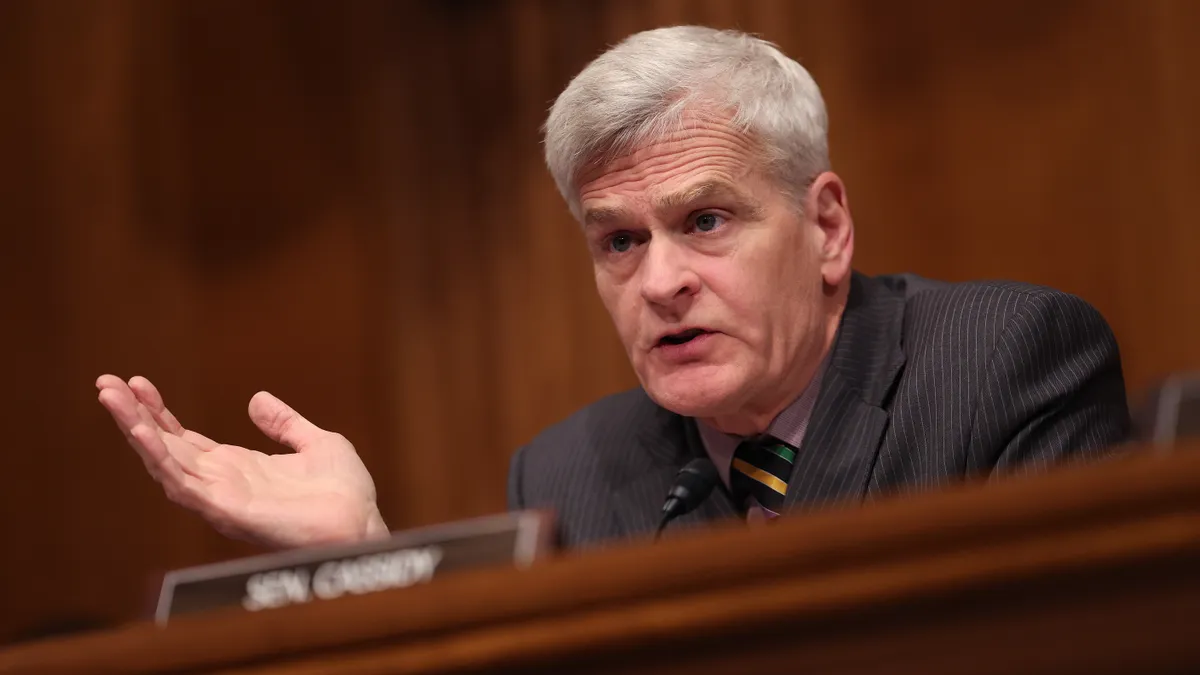More employers, fed up with the ever-rising cost of healthcare, are turning to riskier insurance arrangements, swayed by messaging from brokers to ditch the status quo.
For years, large employers opted for self-insured plans as they had enough employees to spread the risk of a potentially high-cost year due to severe illnesses or injuries. Smaller employers tend to pick fully-insured plans in which the insurer takes on the risk and pays claims as they arise throughout the year.
Now there are signs that more employers, even smaller ones, are making the jump to the riskier arrangements, in some cases known as administration services only plans or ASOs.
That includes the owner of an auto group in North Carolina, who cautioned it's not always smooth sailing.
"In a nutshell, has it been an easy two to three years? No. But it has to be the way we go because healthcare costs are just going absolutely stupid," Gerry Wood, owner of Gerry Wood Auto Group, told HR Dive sister publication Healthcare Dive of the transition.
His group has started to see savings, he said. He now has about 135 people on the company plan and they're approaching their fourth renewal. Wood has opted to tailor his plan in a way that pays providers a percentage of Medicare, also known as a reference-based pricing plan. Wood believes it's one tool a self-insured plan can use to help put a clamp on healthcare prices.
Typically, in a fully-insured plan, a health insurance sets up a network promising physicians who opt in access to a pool of insured people. In theory, the larger the pool, the greater pricing concessions an insurer can extract from those physicians, or health systems, who are essentially trading price discounts for access to more potential patients. Physicians agree to set rates in those arrangements.
Still, employers tell Healthcare Dive these plans are a lot of work and require a much more engaged and educated staff when it comes to using their plans.
"You can't be in it a little bit," Wood said. "You're either committed to this form of healthcare payment plan or you're not. If you have a faint heart, stay out of it."
Cigna told Healthcare Dive it has seen an uptick in employers covered by self-insured arrangements among, including smaller employers, and CVS Health also said it has seen an increased interest. Data from the Kaiser Family Foundation also shows a modest increase in the number of employees covered by these plans in the small group market over time.
Still, some experts are concerned about whether employers understand the depth of the financial risks of such arrangements.
'It's worth it.'
Wisconsin-based company Palmer Johnson Power Systems switched to a self-insured arrangement when it had just 70 employees in 2012. The company logged such drastic savings that it took employees on a trip to popular ski town Vail, Colorado, in 2018.
"We basically said that we are going to share our wins," Ashley Matthys, director of human resources for Palmer Johnson, told Healthcare Dive.
However, in 2019, the company experienced a higher claims year and had to increase employee premiums by 10%.
Morgan Creek Capital in North Carolina switched to a self-insured arrangement with about 35 people under the plan and has experienced multiple years of significant savings, CFO Nick Taylor told Healthcare Dive. "It's worth it," he said.
These employers aren't alone. Some of the nation's largest insurers have noted an increase in self-funded arrangements and among smaller employers.
CVS, which reported a nearly 2% bump in members enrolled in self-funded plans from 2018 to 2019, acknowledged a growing interest among small employers for self-insured plans. "We are seeing more employers of all sizes, including more small-sized groups than in the past, evaluating alternative funding vehicles versus traditional full-insured funding products," a spokesman told Healthcare Dive.
Cigna noted an increased customer base for ASO in its 2018 annual filing.
When asked to characterize the types of employers opting for these plans, a Cigna spokesman told Healthcare Dive: "For 2018 — we saw increases across all of our market segments — small, medium, and large employers." There was a 2% increase in the number of members in ASO plans at the end of 2018 compared to the prior year, though that figure remained flat from 2018 to the end of 2019.
Anthem noted a less than 1% rise in self-funded plan membership, or the addition of 131,000 lives at the end of 2019 compared to the prior year.
UnitedHealthcare reported a 4% rise in self-funded membership in 2019 compared to the prior year and said the increase was primarily due to an acquisition.
For insurers, self-funded enrollment tends to dwarf fully-insured enrollment though fully-insured plans can be more profitable.
"Our healthcare products that involve greater potential risk generally tend to be more profitable than administrative services products and those healthcare products where the employer groups assume the underwriting risks," Anthem said in its annual filing.
Concerns over risks, adverse selection
Policy experts are worried these employers are unaware of all the potential financial risks over time. Even though these employers may be seeing relief in the form of lower premiums, it comes at a potentially greater cost to the traditional small group market and employee benefits, experts said.
"Some small employers can benefit from that, but the question is how long?" Linda Blumberg, an economist and fellow at Urban Institute's Health Policy Center, told Healthcare Dive.
To make these plans work — especially for those lacking thousands of employees — employers opt for stop-loss coverage, also known as reinsurance, protecting them from a year of exorbitant medical claims.
Still, many times that stop-loss coverage is not guaranteed indefinitely because it's underwritten, based on the health status of the group.
"If you have a bad year, you could lose your reinsurance or the cost of it could go up enormously and then you're in a situation where maybe you turn around and you start buying fully-insured coverage," Blumberg said. Essentially, it's dumping bad risk into the fully-insured market.
If it turns into a larger trend, then it could create the kind of bifurcated healthcare landscape that existed prior to the Affordable Care Act, Sabrina Corlette, an expert on healthcare policy and a research professor at Georgetown University, told Healthcare Dive.
Healthier groups of employers will migrate to the self-insured arrangements, potentially leaving behind employer groups that are less healthy in the fully-insured market and creating adverse selection.
"Premiums could go up for everyone else," Corlette said.
Plus, these self-insured plans aren't required to provide the essential health benefits the ACA requires, allowing employers leeway to potentially provide skimpier benefits, which could also lead to lower costs.
Also, it potentially exposes employers to significant costs if they lose their reinsurance but high-cost claims continue to come in after the year end, which is common in healthcare particularly if surgery or care was provided in December. Sometimes reinsurance plans can come with a promise to cover these "claims tail" as they're sometimes called, but not all do.
"It's a little bit of buyer beware," Corlette said.
There was a concern that in the wake of the ACA, smaller employers with younger and healthier employees would be tempted to self-fund, according to a 2015 paper from the National Association of Insurance Commissioners.
Prior to the landmark law, there was little authoritative data on what types of employers self-funded, so the ACA requires the U.S. Department of Labor to provide annual reports on self-funded plans. But there is a limitation to the data: It does not include employers with fewer than 100 employees.
Still, some are challenging the assumption that large employers — armed with self-insured plans — are better than traditional insurers at controlling costs.
Drew Altman with the Kaiser Family Foundation debunked that assumption in a recent column analyzing two decades worth of employee premium data.
Over the course of 20 years, from 1999 to 2019, the average annual premiums for families in self-insured plans versus a fully insured plan mirrored one another.
"There hasn't been a meaningful difference for the past 20 years," Altman wrote.
The findings raise questions about whether smaller employers self insuring can bend the cost curve when seemingly large employers have struggled.
The brokers evangelizing self-insured plans
One potential driver of the move toward these plans are brokers spread out across the country trying to convince smaller firms that by taking total control of their healthcare benefits they can cut costs. It's these brokers who are encouraging employers such as Palmer Johnson in Wisconsin and the auto group in North Carolina to reject the status quo.
Disillusioned with the way benefits have been delivered historically, some brokers have turned toward organizations like Health Rosetta, a firm that provides them a blueprint on how to tailor benefits in a way that cut out the middlemen and promote transparency.
These brokers have turned toward public speaking or the internet to evangelize their message. It's through these videos and presentations that they convince some of the employers to adopt these new benefits and work with these brokers.
Instead of taking a commission from insurers, these brokers say they make money taking fees from their clients, which they say is more transparent and better aligns their interests with that of their clients.
Health Rosetta, which has more than 100 certified brokers across the country, was founded by David Chase in 2015. Chase, who helped create patient relationship management company Avado, fervently talks in speeches posted online about how the fixes to healthcare are within grasp and already exist, but also how many have been made to believe that healthcare is too complicated to fix.
Correction: In a previous version of this article, the founding date of Health Rosetta was incorrect. The company was founded in 2015. The number of brokers certified with the company has also been updated.






















